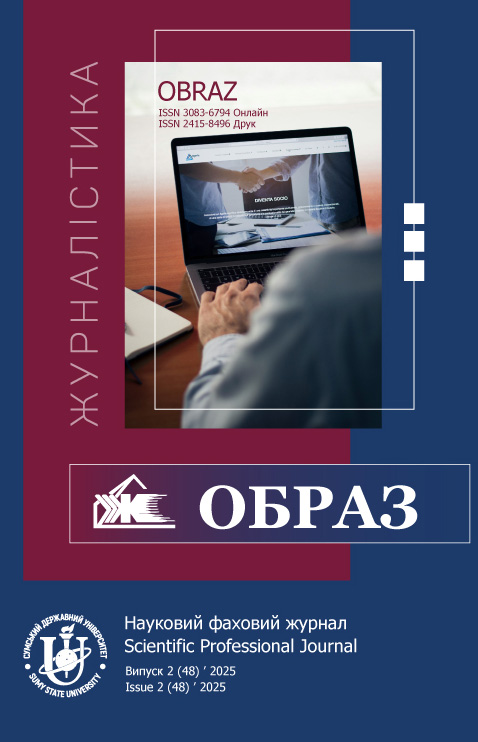Abstract
Introduction. The rapid digitalization of the educational process and the integration of cross-media formats into educational publishing necessitate a fundamental rethinking of editorial approaches. The lack of comprehensive research into editorial workflow transformations in the development of textbooks with interactive digital components increases the relevance of this topic.
Relevance and Purpose. This study aims to identify changes in the production processes of educational publishing caused by the implementation of the cross-media textbook. The primary objective is to identify changes in the competencies and functions of editors resulting from transformations in editorial and publishing processes in educational book publishing, influenced by cross-media production.
Methodology. The research employed a questionnaire survey of editors working in educational publishing, along with a comparative analysis of editorial practices in journalism and publishing, taking into account current media convergence trends.
Results. The findings show that the shift toward cross-media production requires the expansion of editorial teams with IT specialists, the modernization of internal communication, and the acquisition by editors of skills related to digital content creation and evaluation, universal design, and project management. The study also revealed a low level of systematic professional development for editors and a lack of internal standards for working with digital content in publishing houses.
Conclusions. This study is the first to summarize editorial and production transformations in Ukraine’s educational publishing sector under the influence of cross-media technologies. It proposes the development of a technological roadmap for creating printed textbooks with electronic interactive supplements, the implementation of training programs for adapting editorial competencies, and the establishment of a professional development system for editors. These measures aim to ensure consistent quality of educational content in the face of rapid changes.
References
1. Doyle, G. (2015). Multi-platform media and the miracle of the loaves and fishes. Journal of Media Business Studies, 12(1), 49–65. https://doi.org/10.1080/16522354.2015.1027113
2. Bläsi, C. (2021). Bhaskar’s Theory of Publishing and Its Contribution to Theorizing (Evolving New Forms of) Educational Media. В P. Bagoly-Simó & Z. Sikorová (Eds.), Textbooks and Educational Media: Perspectives from Subject Education (p. 59–66). Springer International Publishing. https://doi.org/10.1007/978-3-030-80346-9_5
3. Pro osvitu [On education] : Zakon Ukrayiny vid 05.09.2017 № 2145-VIII : stanom na 1 cherv. 2025 r. URL: https://zakon.rada.gov.ua/laws/show/2145-19#Text (last accessed: 28.06.2025).
4. Erdal, I. J. (2008). Cross-media news journalism: Institutional, professional and textual strategies and practices in multi-platform news production (Doctoral dissertation, University of Oslo). University of Oslo Digital Repository. https://www.duo.uio.no/handle/10852/27240
5. Zhenchenko, M. Cross-media management in convergent media outlets. Naukovi zapysky Instytutu zhurnalistyky [Scientific Notes of the Institute of Journalism] : Collection of Scientific Papers. Kyiv, 2015. Vol. 28. Pp. 70–75.
6. Vasylik, L. Convergence and cross-media: discourse of the terminological paradigm. Bulletin of Lviv Polytechnic National University. Series: Journalistic sciences. 2017. No. 883. P. 3–9. URL: https://doi.org/10.23939/sjs2017.01.003 (last accessed: 28.06.2025).
7. Lepka, Y. Cross-media audience of the news agency ‘112.ua’. Naukovi doslidzhennya ukrayinskoho mediynoho kontentu: sotsialnyy vymir [Scientific research of Ukrainian media content: social dimension]. 2017. Issue 2. Pp. 36–42.
8. Herasymova O. O., Zhenchenko M. I. Crossmedia textbooks: concepts, classification, problems of editorial and publishing preparation. Printing and Publishing. 2022. V. 1, № 83. P. 125–133. URL: https://doi.org/10.32403/0554-4866-2022-1-83-125-133 (last accessed: 28.06.2025).
9. Zhenchenko, M., Zhenchenko, I., Melnik, O., & Miroshnichenko, V. (2020). Electronic textbooks for Ukrainian education: Statistics, models of development, quality problems. In ICT in Education, Research and Industrial Applications. Integration, Harmonization and Knowledge Transfer (Vol. 2732, pp. 721–733). CEUR Workshop Proceedings. http://ceur-ws.org/Vol-2732/
10. Figol N. Assessment of the effectiveness of electronic educational publications. Tekhnolohiya i tekhnika drukarstva [Technology and printing techniques]. 2017. No. 3 (57). Pp. 86–92. URL: https://doi.org/10.20535/2077-7264.3(57).2017.122314 (last accessed: 28.06.2025).
11. Menke, M., Kinnebrock, S., Kretzschmar, S., Aichberger, I., Broersma, M., Hummel, R., Kirchhoff, S., Prandner, D., Ribeiro, N., & Salaverría, R. (2018). Convergence Culture in European Newsrooms: Comparing editorial strategies for cross-media news production in six countries. Journalism Studies, 19(6), 881–904. https://doi.org/10.1080/1461670X.2016.1232175
12. Herasymova, O. (2025). Survey Questionnaire: Editorial practices in publishing cross-media textbooks (Версія 1) [Data set]. Zenodo. https://doi.org/10.5281/zenodo.15761785
13. Meier, K.; Bracker, I. y Verhovnik, M. (2017). Technological innovation and convergent journalism. Case study on the transformation process of Bavaria’s public broadcasting service. Revista Mediterránea de Comunicación/ Medterranean Journal of Communication, 8(1), 33-44. https://www.doi.org/10.14198/MEDCOM2017.8.1.3
14. El Takach, A., Nassour, F., & Hejase, H. J. (2023). Digital Transformation of Media Companies in Lebanon from Traditional to Multiplatform Production: An Assessment of Lebanese Journalists’ Adaptation to the New Digital Era. Žurnalistikos Tyrimai, 16, 152–173. https://doi.org/10.15388/ZT/JR.2022.6
15. Herasymova O. Editorial Professions: which Sciences and Industry Sectors Shape Modern Specialists for Educational Publishing. Naukovi zapysky Instytutu zhurnalistyky [Scientific Notes of the Institute of Journalism]. 2025. № 86. P. 145–157. URL: https://doi.org/10.17721/2522-1272.2025.86.14 (last accessed: 28.06.2025).
16. Pro zatverdzhennia Vymoh do interaktyvnoho elektronnoho dodatka do pidruchnyka : Nakaz MON Ukrainy vid 19.04.2024 № 548 : stanom na 29 trav. 2024 r. URL: https://zakon.rada.gov.ua/laws/show/z0656-24#Text (last accessed: 28.06.2025).
17. Pro zatverdzhennia Polozhennia pro elektronnyi pidruchnyk : Nakaz MON Ukrainy vid 02.05.2018 № 440 : stanom na 12 lyp. 2019 r. URL: https://zakon.rada.gov.ua/laws/show/z0621-18#Text (last accessed: 28.06.2025).
18. Lytvynova S., Sukhikh A., Melnyk O. Vykorystannia platformy «Vseukrainska shkola onlain» v umovakh voiennoho stanu: rezultaty vseukrainskoho opytuvannia. Information Technologies and Learning Tools. 2024. V. 104, № 6. P. 31–52. URL: https://doi.org/10.33407/itlt.v104i6.5658 (last accessed: 28.06.2025).

This work is licensed under a Creative Commons Attribution 4.0 International License.

